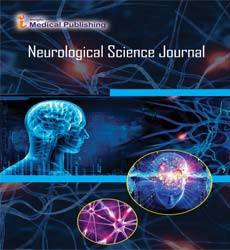Understanding Psychological Issues and Cognitive Disorders: The Computational Point of View
Dennis Ruppin*
Department of Neurology, Oklahoma University, Norway, USA
- *Corresponding Author:
- Dennis Ruppin
Department of Neurology,
Oklahoma University,
Norway,
USA,
E-mail: dennis21ruppin@edu.in
Received Date: August 04, 2021 Accepted Date: August 18, 2021 Published Date: August 25, 2021
Citation: Ruppin D (2021) Understanding Psychological Issues and Cognitive Disorders: The Computational Point of View. Neurol Sci J Vol. 5 No. 4:1
Description
The last decade has seen expanding revenue in computational examinations of mind working. It is simply normal to ask how such neural displaying might be bridled to examine the pathogenesis or expected treatment of cerebrum issues, and in what ways may computational strategies supplement more conventional examination techniques. In fact, early endeavors toward this path have been widely evolved lately. The current book presents an assortment of papers on this point, many introduced at the Second International Workshop on Neural Modeling of Brain and Cognitive Disorders, held at the University of Maryland in June 1998. To consider cerebrum or intellectual problems computationally, one initially needs to build a model organization which is equipped for playing out some fundamental capacities, like controlling developments or putting away and recovering remembered data. From that point, by lessoning the unblemished organization's primary parts or disturbing its dynamic components, the particular neuroanatomical and neurophysiological discoveries accepted to portray the pathogenesis of the sickness can be displayed, and the subsequent changes in the conduct of the organization can be analyzed. It is then likewise conceivable to look for instruments which might balance the harming impacts of the recreated obsessive 'injuries'. Neural models are restricted in that they essentially work on the natural wonders happening in the sensory system and are for the most part obliged in size. The mimicked sores in such models are considerable rearrangements of unusual occasion’s oncoming inside the cerebrum andor in psychological cycles. By and by, such PC based models supplement conventional techniques for contemplating mind problems in generous and significant manners. The size and area of mimicked cerebrum harm can be controlled absolutely and can be deliberately changed over discretionarily huge quantities of test 'subjects' and data handling assignments. Further, the computational analyses are available to itemized review in manners that natural frameworks are not, allowing one to decide the fundamental systems and follow the social changes following organization harm or lesion.
Neural models of cerebrum and intellectual issues, as neural organization models as a rule, shift broadly in the degree of 'authenticity' in which they mean to mode the basic marvels to be considered. This is valid both concerning the degree of organic detail utilized in portraying the individual structure blocks themselves and furthermore with respect to the depiction level of the organization's engineering. This variety in natural authenticity shows itself in the models introduced in this volume. As anyone might expect, the parts tending to neuropsychological or intellectual problems will in general portray more theoretical models, genuinely eliminated from explicit cerebrum designs, contrasted and the models introduced in parts tending to neurological and mental problems. Subsequently, the examinations talked about in the book length a rich range of issues, yet in addition cut across a wide assortment of displaying levels and approaches, including feed forward, input and compartmental models. Before we continue to sum up the broad group of work showing up in this book, we initially give a concise outline of a portion of the past research in the field.
Conclusion
Past models of Alzheimer's illness have brought about two fundamental speculations concerning the pathogenesis of Alzheimer's illness. As indicated by the main methodology, disappointment of neuronal synaptic compensatory components assumes an essential part in Alzheimer's illness pathogenesis. Diverse disappointment examples could represent the noticed variety in the seriousness and movement pace of Alzheimer's illness. It was likewise shown that synaptic pay can be completed effectively by a nearby, dynamic instrument, where every neuron keeps up with the profile of its approaching postsynaptic current. This neural guideline component, which is currently thought to play a significant job in typical data handling in the mind, exhibits the capability of finding out about ordinary cerebrum working from displaying its pathologies. An alternate theory concerning the pathogenesis of Alzheimer's infection has been advanced in Hasselmo. These investigations have zeroed in on synaptic runaway, an obsessive outstanding development of synaptic associations that might happen because of impedance by recently put away memory designs during the capacity of new examples. When synaptic runaway happens, its expanded metabolic requests or excitotoxic impacts could probably be adequately extreme to cause neuronal degeneration, corresponding to that found in Alzheimer's illness. Curiously, the example of spread of neurotic harm in Alzheimer's infection fits well the theory of synaptic runaway. Models of central stroke have been created to address the occasions happening promptly following the intense ischemic occasion, and furthermore later on during the ongoing, redesign stage. Normally, these models vary in the sort of computational system included. Models of intense central stroke envelop a joined neural/metabolic portrayal that follows the worldly advancement of a few factors that assume a basic part in ischemic stroke. It effectively duplicated a few test conditions and makes testable expectations about the number, speed and term of ischemic CSD waves.
Open Access Journals
- Aquaculture & Veterinary Science
- Chemistry & Chemical Sciences
- Clinical Sciences
- Engineering
- General Science
- Genetics & Molecular Biology
- Health Care & Nursing
- Immunology & Microbiology
- Materials Science
- Mathematics & Physics
- Medical Sciences
- Neurology & Psychiatry
- Oncology & Cancer Science
- Pharmaceutical Sciences
